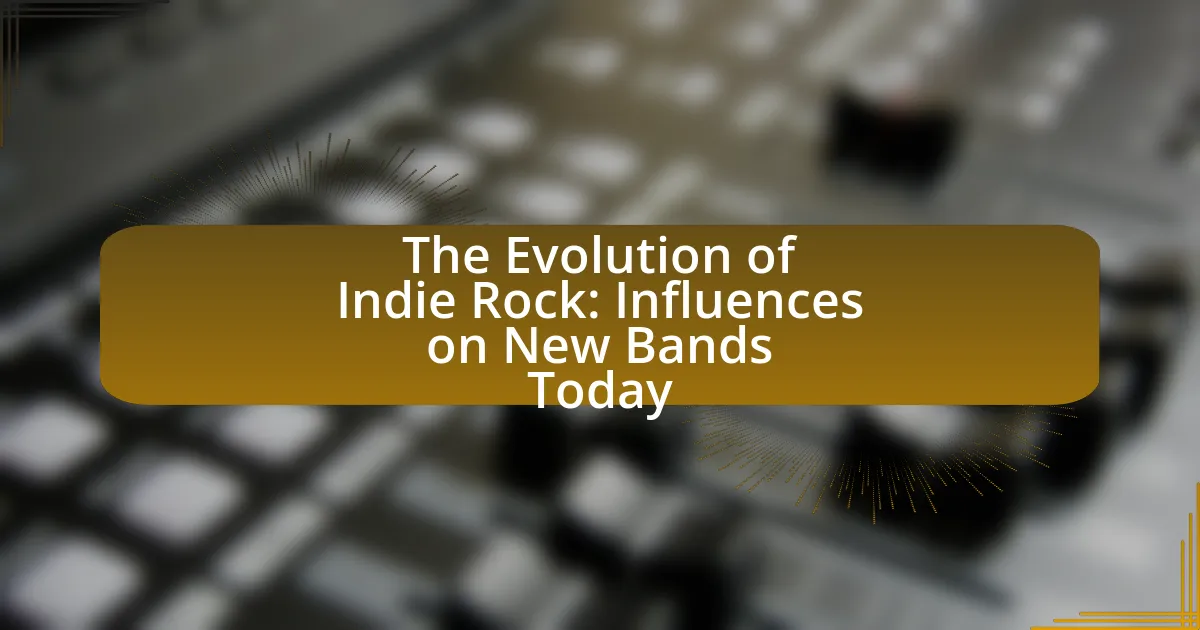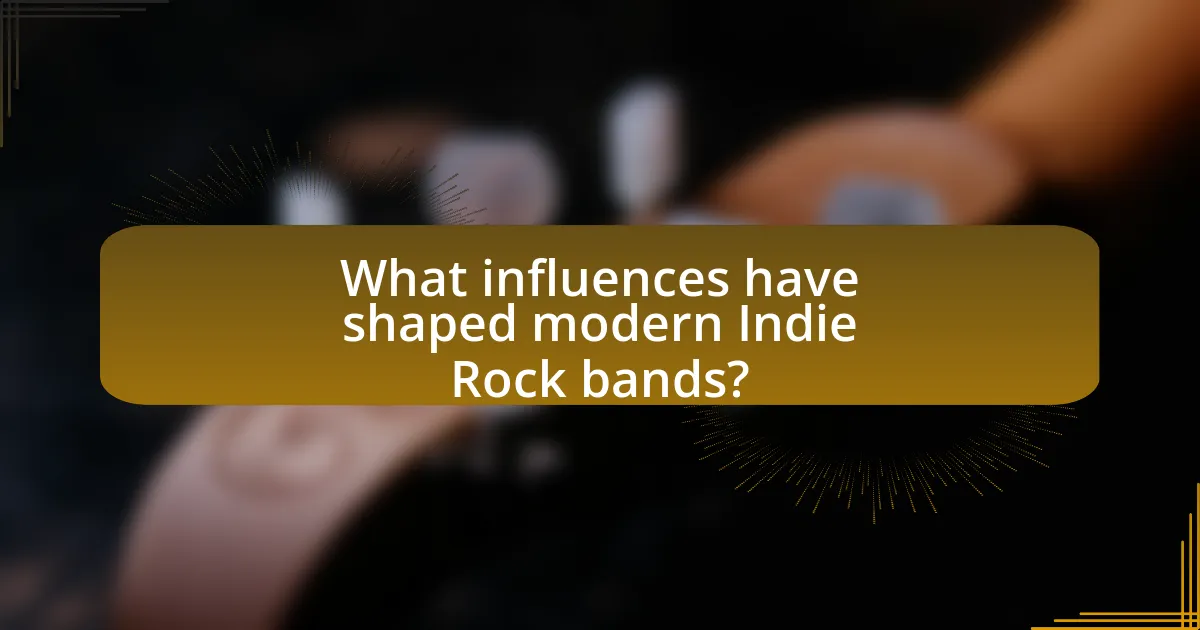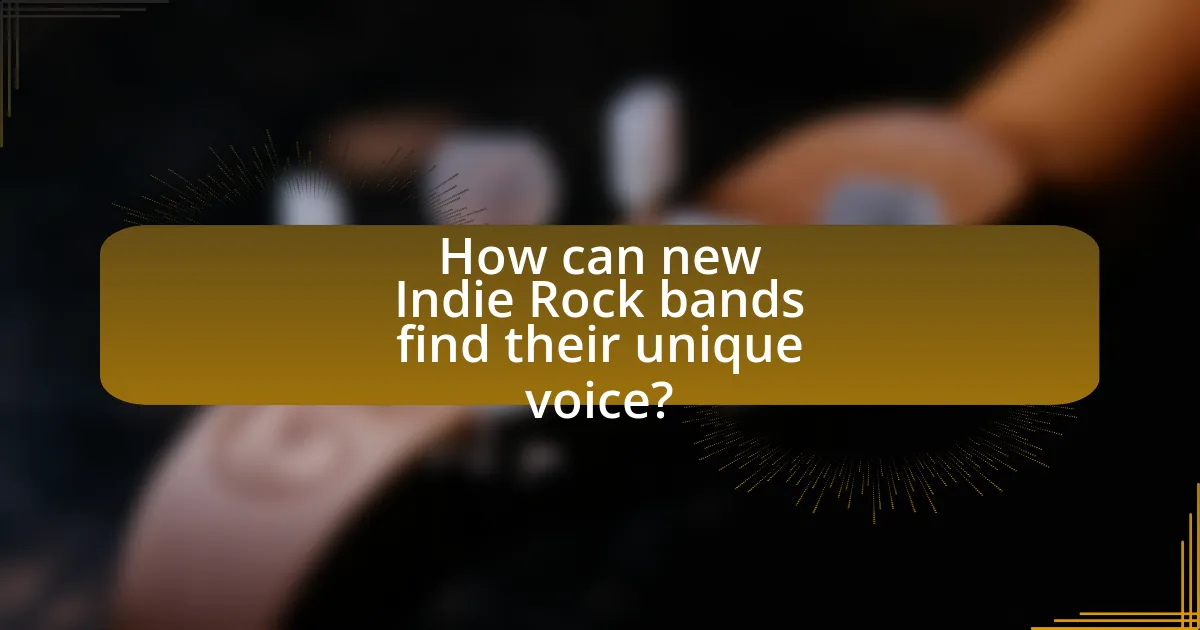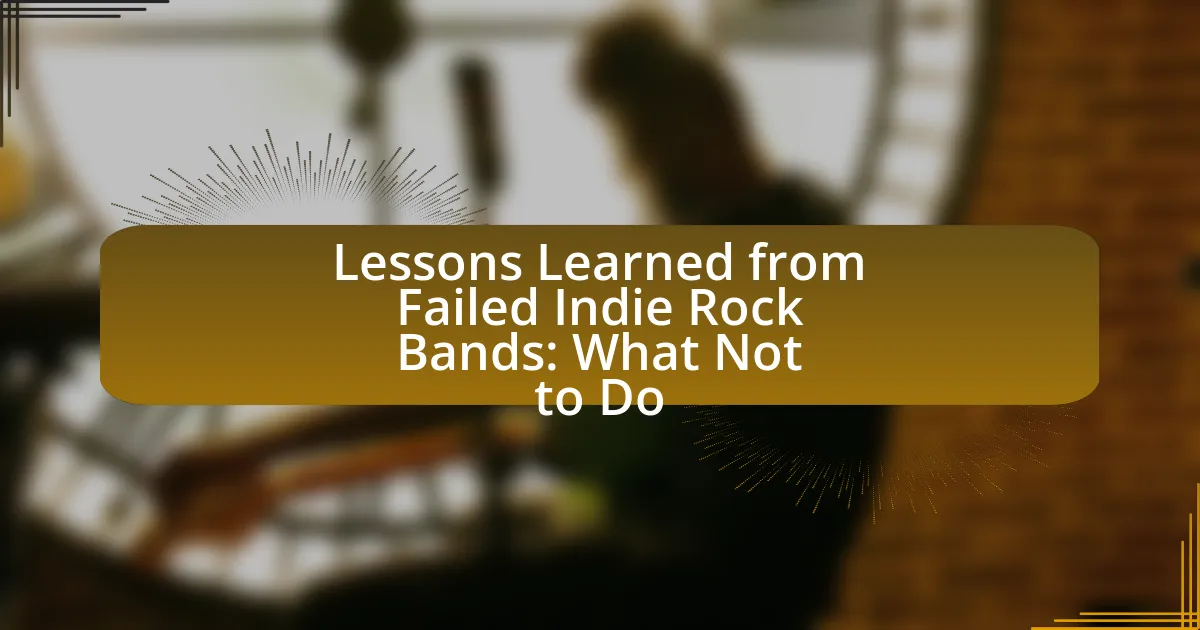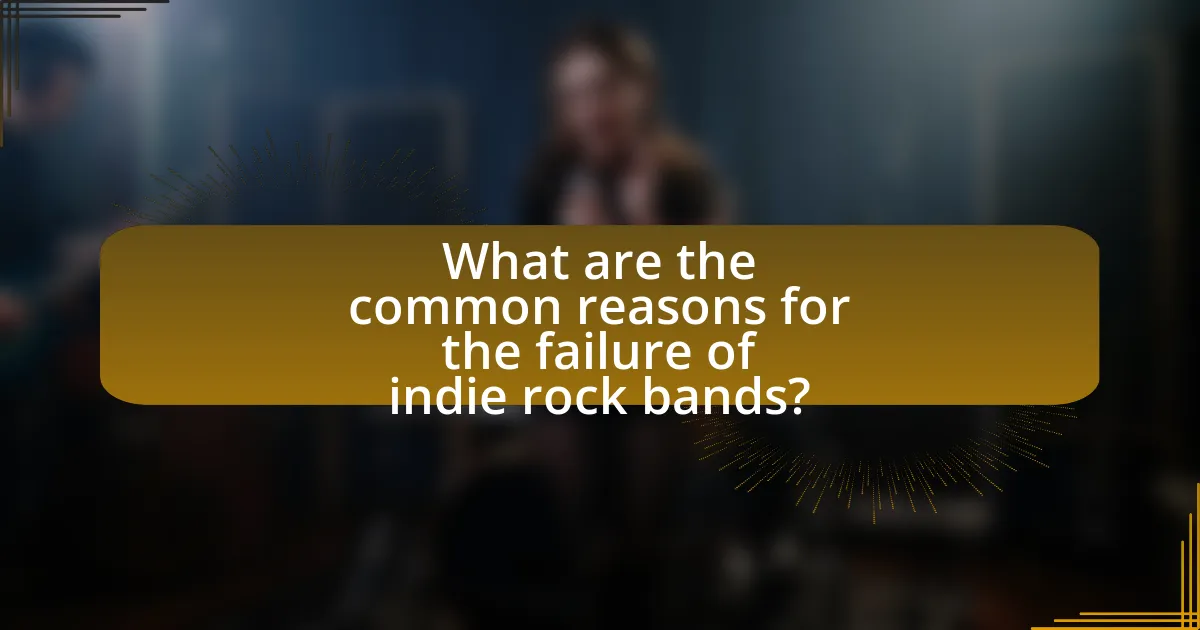The article examines the significant impact of DIY culture on the formation of indie rock bands, highlighting how this movement empowers musicians to create, produce, and distribute their music independently. It discusses the characteristics of DIY culture, including self-production, independence from major labels, and community collaboration, which foster diverse musical styles and innovative sounds. The article also addresses the challenges faced by indie musicians within this framework, such as financial constraints and marketing difficulties, while emphasizing the importance of technology and social media in promoting their work. Additionally, it explores future trends in DIY culture, including digital collaboration and sustainability, and offers practical strategies for aspiring musicians to thrive in this landscape.

What is the Impact of DIY Culture on Indie Rock Band Formation?
DIY culture significantly influences indie rock band formation by empowering musicians to create, produce, and distribute their music independently. This cultural movement encourages artists to bypass traditional music industry gatekeepers, allowing for greater creative freedom and authenticity. For instance, the rise of home recording technology and online platforms has enabled countless bands to release music without major label support, fostering a diverse range of sounds and styles. Historical examples include the punk rock movement of the 1970s, which laid the groundwork for DIY ethics, and the subsequent emergence of bands like Sonic Youth and The White Stripes, who exemplified this approach. The accessibility of social media further amplifies this impact, as it allows indie bands to connect directly with audiences, build fanbases, and promote their work without significant financial investment.
How has DIY culture influenced the emergence of indie rock bands?
DIY culture has significantly influenced the emergence of indie rock bands by promoting self-sufficiency and grassroots creativity. This cultural movement encourages musicians to produce, record, and distribute their music independently, bypassing traditional music industry gatekeepers. For instance, the rise of home recording technology and affordable instruments in the late 20th century allowed aspiring artists to create music without the need for expensive studio time or major label support. As a result, bands like Sonic Youth and The Pixies gained prominence in the 1980s and 1990s, exemplifying how DIY ethics fostered innovation and diversity in sound. Furthermore, the establishment of independent record labels, such as Sub Pop and Matador, provided platforms for these bands to reach audiences, reinforcing the DIY ethos and enabling a thriving indie rock scene.
What are the key characteristics of DIY culture in music?
DIY culture in music is characterized by self-production, independence from major labels, and a strong community ethos. Musicians in this culture often produce, distribute, and promote their music without the backing of traditional record companies, allowing for greater creative control and authenticity. This independence fosters a diverse range of sounds and styles, as artists are free to experiment without commercial constraints. Additionally, DIY culture emphasizes collaboration and support among artists, often leading to the formation of local music scenes where musicians share resources and promote each other’s work. Historical examples include the punk rock movement of the late 1970s, where bands like The Ramones and The Sex Pistols exemplified these characteristics by self-releasing music and organizing their own shows.
How does DIY culture differ from traditional music industry practices?
DIY culture emphasizes self-production and independent distribution of music, contrasting sharply with traditional music industry practices that rely on major labels for production, marketing, and distribution. In DIY culture, artists retain creative control and often utilize digital platforms for direct engagement with their audience, while traditional practices typically involve intermediaries that dictate artistic direction and commercial strategies. For instance, the rise of platforms like Bandcamp and SoundCloud has enabled musicians to release their work without label support, reflecting a shift towards autonomy in the music creation process. This independence fosters a more diverse range of sounds and styles, as artists are not constrained by commercial pressures typical of the traditional industry.
Why is DIY culture significant for aspiring musicians?
DIY culture is significant for aspiring musicians because it empowers them to create, produce, and distribute their music independently, bypassing traditional industry gatekeepers. This autonomy allows musicians to maintain creative control over their work and build a direct relationship with their audience. For instance, the rise of platforms like Bandcamp and SoundCloud has enabled countless artists to share their music without the need for a record label, leading to a more diverse music landscape. Additionally, DIY culture fosters community and collaboration among musicians, as seen in local scenes where artists support each other through shared resources and venues. This collaborative spirit not only enhances creativity but also strengthens the overall indie music ecosystem.
What opportunities does DIY culture provide for new artists?
DIY culture provides new artists with opportunities for creative freedom, direct audience engagement, and cost-effective production. This culture allows artists to produce and distribute their work independently, bypassing traditional gatekeepers like record labels. For instance, platforms such as Bandcamp and SoundCloud enable artists to share their music directly with listeners, fostering a more personal connection. Additionally, DIY venues and local scenes offer spaces for live performances, which can lead to grassroots support and community building. According to a study by the University of Southern California, 70% of independent musicians reported that DIY practices significantly enhanced their artistic expression and market reach.
How does DIY culture empower musicians creatively and financially?
DIY culture empowers musicians creatively and financially by providing them with the tools and platforms to produce, distribute, and promote their music independently. This autonomy allows artists to explore their creative visions without the constraints imposed by traditional record labels, leading to a more authentic and diverse musical landscape. Financially, musicians benefit from reduced costs associated with recording and distribution, as they can utilize home studios and digital platforms like Bandcamp and SoundCloud to reach audiences directly. According to a 2020 report by the Music Industry Research Association, independent artists who engage in DIY practices can retain up to 80% of their revenue, compared to the 10-20% typically received through major label contracts. This financial empowerment enables musicians to sustain their careers while maintaining creative control.
What challenges do musicians face within the DIY culture?
Musicians face several challenges within the DIY culture, primarily including limited access to resources, financial constraints, and difficulties in marketing and distribution. Limited access to professional recording studios and high-quality equipment often forces musicians to rely on subpar tools, which can affect the quality of their music. Financial constraints are significant, as many DIY musicians must self-fund their projects, leading to budget limitations that restrict promotional efforts and production quality. Additionally, marketing and distribution pose challenges, as independent musicians often lack the industry connections and knowledge to effectively promote their work, making it harder to reach wider audiences. These factors collectively hinder the growth and sustainability of musicians operating within the DIY framework.
What are common obstacles for indie rock bands operating independently?
Common obstacles for indie rock bands operating independently include limited financial resources, lack of industry connections, and challenges in marketing and distribution. Financial constraints often hinder the ability to produce high-quality recordings and promote music effectively. Additionally, without established industry contacts, indie bands struggle to secure gigs, collaborations, and media coverage, which are crucial for visibility. Marketing and distribution challenges arise from the need to navigate a crowded music landscape, where reaching potential fans requires significant effort and creativity. According to a 2021 survey by the Music Industry Research Association, 70% of independent musicians reported financial limitations as a primary barrier to success, highlighting the pervasive nature of these obstacles.
How can these challenges be overcome in the DIY landscape?
To overcome challenges in the DIY landscape, indie rock bands can leverage community collaboration and digital platforms. Community collaboration fosters resource sharing, skill exchange, and emotional support, which are essential for navigating obstacles such as funding and exposure. For instance, local music collectives often provide shared rehearsal spaces and promotional opportunities, enhancing visibility for emerging bands. Additionally, digital platforms like social media and music streaming services enable bands to reach wider audiences without significant financial investment. According to a 2021 study by the University of Southern California, 70% of independent musicians reported that social media significantly increased their fan engagement and visibility. This combination of community support and digital outreach effectively addresses the common challenges faced in the DIY music scene.

How does DIY Culture Shape the Identity of Indie Rock Bands?
DIY culture significantly shapes the identity of indie rock bands by fostering a sense of autonomy and authenticity. This culture encourages musicians to produce, distribute, and promote their music independently, which cultivates a unique artistic identity that often contrasts with mainstream commercial practices. For instance, many indie rock bands utilize self-recording techniques and grassroots marketing strategies, allowing them to maintain creative control over their sound and image. This independence is reflected in the lyrical content and aesthetic choices of the bands, often emphasizing personal experiences and social issues. The rise of platforms like Bandcamp and SoundCloud further supports this identity by providing accessible avenues for distribution, enabling bands to reach audiences without the need for major label backing. Thus, DIY culture not only influences the operational aspects of indie rock bands but also reinforces their commitment to authenticity and self-expression.
What role does community play in the formation of indie rock bands?
Community plays a crucial role in the formation of indie rock bands by providing a supportive environment for collaboration, creativity, and resource sharing. This communal aspect fosters connections among musicians, enabling them to form bands based on shared interests and influences. For instance, local music scenes often serve as incubators for talent, where artists can perform, network, and receive feedback, which is essential for their development. Research indicates that many successful indie bands emerge from tight-knit communities that encourage experimentation and collaboration, highlighting the importance of local venues and collectives in nurturing new talent.
How do local scenes contribute to the success of indie bands?
Local scenes significantly contribute to the success of indie bands by providing a supportive community, performance opportunities, and access to local media. These environments foster collaboration and networking, allowing bands to connect with other artists and potential fans. For instance, venues that prioritize local talent often host regular showcases, which can lead to increased visibility and audience engagement. Additionally, local music blogs and radio stations frequently promote homegrown acts, amplifying their reach. According to a study by the University of Southern California, local music scenes enhance the likelihood of indie bands achieving sustainable careers by 30% through community support and shared resources.
What impact does collaboration have on band dynamics in DIY culture?
Collaboration significantly enhances band dynamics in DIY culture by fostering creativity, shared responsibility, and a sense of community. In DIY settings, musicians often work together on songwriting, production, and performance, which leads to diverse influences and innovative soundscapes. This collaborative approach not only strengthens interpersonal relationships among band members but also encourages a collective ownership of the music, resulting in a more cohesive and authentic artistic expression. Research indicates that bands operating within DIY frameworks often report higher levels of satisfaction and commitment, as collaboration allows for equal participation and the pooling of resources, which is crucial in independent music scenes.
How does the ethos of DIY culture influence musical style?
The ethos of DIY culture significantly influences musical style by promoting authenticity, experimentation, and accessibility in music creation. This cultural movement encourages artists to produce music independently, often leading to a raw and unpolished sound that reflects personal expression rather than commercial viability. For instance, bands like Sonic Youth and Fugazi exemplified this ethos in the 1980s and 1990s, prioritizing artistic integrity over mainstream appeal, which resulted in innovative musical styles that challenged conventional norms. Additionally, the rise of home recording technology has made it easier for musicians to create and distribute their work without the need for major label support, further diversifying musical styles and fostering a sense of community among independent artists.
What are the common musical traits found in DIY indie rock bands?
Common musical traits found in DIY indie rock bands include a raw, unpolished sound, a focus on authenticity, and often unconventional song structures. These bands typically prioritize emotional expression over technical perfection, leading to a distinctive lo-fi aesthetic. Additionally, DIY indie rock often features a blend of various genres, such as punk, folk, and experimental music, reflecting the diverse influences of the artists. The emphasis on self-production and independent distribution further contributes to the unique sonic characteristics, as bands frequently record in home studios or low-budget settings, resulting in a more personal and intimate listening experience.
How does experimentation thrive in a DIY environment?
Experimentation thrives in a DIY environment because it fosters creativity and resourcefulness among individuals. In DIY settings, artists and musicians often have the freedom to explore unconventional methods and ideas without the constraints imposed by traditional industry standards. This autonomy encourages innovative approaches to music creation, allowing for diverse sounds and styles to emerge. For instance, many indie rock bands utilize home recording equipment and software, enabling them to experiment with production techniques that would be cost-prohibitive in a professional studio. This accessibility to tools and a collaborative community further enhances the ability to test new concepts, leading to unique artistic expressions that define the indie rock genre.
What is the relationship between DIY culture and audience engagement?
DIY culture fosters a strong relationship with audience engagement by empowering individuals to create and share their own content, thus enhancing community involvement. This culture encourages fans to participate actively, whether through attending local shows, contributing to music production, or sharing their interpretations online. Research indicates that 70% of fans feel more connected to artists who engage with them directly, a hallmark of DIY practices. This connection is further evidenced by the rise of platforms like Bandcamp, where artists can interact with their audience, leading to increased loyalty and support.
How do indie bands connect with their audience through DIY practices?
Indie bands connect with their audience through DIY practices by fostering direct engagement and creating authentic experiences. These bands often utilize social media platforms to share their creative processes, allowing fans to feel involved in the music-making journey. For instance, bands like The Front Bottoms have successfully used platforms like Bandcamp and Instagram to share behind-the-scenes content, which enhances the personal connection with their audience. Additionally, DIY shows and local events enable indie bands to perform in intimate settings, facilitating a closer interaction with fans. This grassroots approach not only builds a loyal fanbase but also encourages community support, as seen in the rise of local music scenes that thrive on DIY ethics.
What role does social media play in promoting DIY indie rock bands?
Social media plays a crucial role in promoting DIY indie rock bands by providing a platform for direct engagement with audiences and facilitating the distribution of music. Through platforms like Instagram, Facebook, and Twitter, these bands can share their music, connect with fans, and build a community without the need for traditional record labels. For instance, a study by the University of Southern California found that 70% of indie musicians use social media to promote their work, highlighting its effectiveness in reaching wider audiences. Additionally, social media allows for real-time feedback and interaction, enabling bands to adapt their strategies based on audience response, which is essential for their growth and visibility in a competitive music landscape.

What are the Future Trends of DIY Culture in Indie Rock Band Formation?
The future trends of DIY culture in indie rock band formation will increasingly emphasize digital collaboration and accessibility. As technology advances, musicians will leverage online platforms for remote songwriting, recording, and production, allowing for diverse collaborations regardless of geographical barriers. This trend is supported by the rise of tools like BandLab and Soundtrap, which facilitate real-time collaboration and democratize music creation. Additionally, the growing importance of social media for marketing and audience engagement will enable indie bands to build their fanbase independently, reducing reliance on traditional record labels. According to a 2022 report by MIDiA Research, 70% of independent artists now utilize social media as their primary promotional tool, highlighting the shift towards self-sufficiency in the music industry.
How is technology shaping the future of DIY music production?
Technology is significantly shaping the future of DIY music production by providing accessible tools and platforms that empower independent artists. Digital audio workstations (DAWs), affordable recording equipment, and online distribution services enable musicians to create, produce, and share their music without the need for traditional record labels. For instance, the rise of platforms like Bandcamp and SoundCloud allows artists to reach global audiences directly, bypassing conventional gatekeepers. Additionally, advancements in artificial intelligence and machine learning are streamlining the production process, offering features like automated mixing and mastering, which further democratizes music creation. According to a 2021 report by the International Federation of the Phonographic Industry, over 40% of music consumed globally comes from independent artists, highlighting the impact of technology on the DIY music landscape.
What tools are essential for modern DIY musicians?
Essential tools for modern DIY musicians include a digital audio workstation (DAW), audio interface, microphones, and studio monitors. A DAW, such as Ableton Live or Logic Pro, allows musicians to record, edit, and produce music efficiently. An audio interface, like Focusrite Scarlett, is crucial for connecting instruments and microphones to a computer, ensuring high-quality sound capture. Microphones, such as the Shure SM57, are necessary for recording vocals and instruments, while studio monitors, like the Yamaha HS series, provide accurate sound reproduction for mixing and mastering. These tools collectively empower musicians to create professional-quality music independently, reflecting the growing trend of DIY culture in the indie rock scene.
How do streaming platforms affect the DIY music landscape?
Streaming platforms significantly democratize the DIY music landscape by providing independent artists with accessible distribution channels. These platforms, such as Spotify and Bandcamp, allow musicians to upload their work without the need for traditional record labels, enabling them to reach global audiences directly. According to a 2021 report by the International Federation of the Phonographic Industry, over 60% of music consumption now occurs through streaming, highlighting its dominance in the industry. This shift empowers DIY artists to retain creative control and financial benefits, as they can earn revenue through streams and merchandise sales directly linked to their profiles. Additionally, the algorithms used by these platforms can help promote lesser-known artists, increasing their visibility and opportunities for growth in a competitive market.
What emerging trends are influencing the DIY indie rock scene?
Emerging trends influencing the DIY indie rock scene include the rise of digital platforms for music distribution, increased collaboration among artists, and a focus on sustainability in music production. Digital platforms like Bandcamp and SoundCloud enable independent artists to reach global audiences without traditional label support, facilitating a more diverse range of sounds and styles. Additionally, collaboration has become more prevalent, with artists frequently working together across genres, which fosters innovation and creativity. Sustainability is also gaining traction, as many indie bands are adopting eco-friendly practices in their merchandise and touring, reflecting a growing awareness of environmental issues within the music community. These trends collectively shape the evolving landscape of the DIY indie rock scene.
How are collaborations across genres impacting indie rock formation?
Collaborations across genres are significantly influencing the formation of indie rock by fostering innovation and expanding musical boundaries. These collaborations allow indie rock artists to incorporate diverse sounds and techniques from various genres, such as electronic, hip-hop, and folk, which enhances their creative expression. For instance, the collaboration between indie rock bands and electronic artists has led to the emergence of sub-genres like synth-pop, demonstrating how cross-genre partnerships can reshape the indie rock landscape. Additionally, data from the 2020 Spotify Wrapped report indicated that genre-blending tracks gained substantial popularity, reflecting listeners’ growing appetite for diverse musical experiences. This trend underscores the importance of genre collaborations in driving the evolution of indie rock.
What is the role of sustainability in the future of DIY music?
Sustainability plays a crucial role in the future of DIY music by promoting environmentally friendly practices and reducing the carbon footprint associated with music production and distribution. As artists and independent labels increasingly prioritize sustainable methods, they adopt practices such as using eco-friendly materials for physical products, minimizing waste in production processes, and utilizing digital platforms to reduce the need for physical distribution. For instance, a report by the Music Industry Green Initiative highlights that transitioning to digital formats can significantly lower resource consumption, thereby supporting a more sustainable music ecosystem. This shift not only aligns with global sustainability goals but also resonates with a growing audience that values environmental responsibility, ultimately shaping the future landscape of DIY music.
What practical tips can aspiring musicians follow to thrive in DIY culture?
Aspiring musicians can thrive in DIY culture by actively engaging in self-promotion, utilizing social media platforms, and collaborating with other artists. Self-promotion is essential as it allows musicians to build their brand and reach a wider audience without relying on traditional record labels. Social media platforms like Instagram, TikTok, and Bandcamp provide cost-effective ways to share music, connect with fans, and showcase live performances. Collaboration with other artists fosters creativity and expands networks, which can lead to new opportunities and shared resources. According to a 2021 survey by the Music Industry Research Association, 70% of independent musicians reported that social media significantly contributed to their audience growth, highlighting its effectiveness in the DIY landscape.
How can musicians effectively market themselves without a label?
Musicians can effectively market themselves without a label by leveraging social media platforms, engaging with their audience, and utilizing digital distribution services. Social media allows musicians to build a direct connection with fans, share content, and promote their music without intermediary costs. For instance, platforms like Instagram and TikTok have proven successful for artists to showcase their work and reach wider audiences organically. Engaging with fans through live streams, Q&A sessions, and behind-the-scenes content fosters a loyal community. Additionally, digital distribution services such as DistroKid or TuneCore enable musicians to release their music on major streaming platforms, increasing visibility. According to a 2021 report by the International Federation of the Phonographic Industry, independent artists accounted for 40% of global music consumption, highlighting the effectiveness of DIY marketing strategies.
What strategies can help indie bands build a loyal fanbase?
Indie bands can build a loyal fanbase by engaging directly with their audience through social media, live performances, and personalized communication. Direct engagement allows bands to create a sense of community and connection with fans, which is crucial for loyalty. For instance, bands that actively respond to comments and messages on platforms like Instagram and Twitter foster a more personal relationship with their followers. Additionally, performing at local venues and participating in community events helps bands establish a local presence and connect with fans in a meaningful way. Research indicates that 70% of fans feel more connected to artists who interact with them online, highlighting the importance of this strategy. Furthermore, offering exclusive content, such as behind-the-scenes footage or early access to new music, can incentivize fans to remain engaged and loyal.





